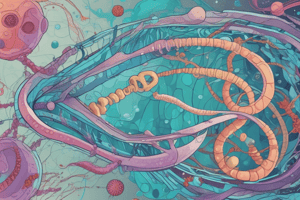Podcast
Questions and Answers
What was the purpose of the filter in the U-tube apparatus used by Bernard Davis?
What was the purpose of the filter in the U-tube apparatus used by Bernard Davis?
- To prevent the passage of genetic material
- To allow the passage of genetic material, but prevent the passage of bacterial cells (correct)
- To allow the passage of bacterial cells
- To mix the two bacterial strains
What is a key difference between genetic transfer in bacteria and sexual reproduction in eukaryotes?
What is a key difference between genetic transfer in bacteria and sexual reproduction in eukaryotes?
- Genetic transfer in bacteria involves a combination of conjugation, transduction, and transformation (correct)
- Genetic transfer in bacteria only involves conjugation
- Genetic transfer in bacteria does not involve genetic recombination
- Genetic transfer in bacteria does not enhance genetic diversity
What was the conclusion of Lederberg and Tatum's experiment?
What was the conclusion of Lederberg and Tatum's experiment?
- The experiment did not provide conclusive evidence for genetic transfer (correct)
- The met+ bio+ thr+ leu+ thi+ strain gained the ability to synthesize biotin and methionine
- The met- bio- thr- leu- thi- strain gained the ability to synthesize threonine and leucine and thiamine
- Both strains exchanged genetic material resulting in a new strain
What is the primary mechanism of genetic transfer in which bacteriophages are involved?
What is the primary mechanism of genetic transfer in which bacteriophages are involved?
What is the primary requirement for the transfer of genetic material between bacterial cells?
What is the primary requirement for the transfer of genetic material between bacterial cells?
What was the function of the U-tube apparatus used by Bernard Davis?
What was the function of the U-tube apparatus used by Bernard Davis?
Why are crosses not used in the genetic analysis of bacterial species?
Why are crosses not used in the genetic analysis of bacterial species?
What is the term for the uptake of genetic material from the environment in bacteria?
What is the term for the uptake of genetic material from the environment in bacteria?
What did the experiment by Lederberg and Tatum demonstrate?
What did the experiment by Lederberg and Tatum demonstrate?
What was the purpose of the experiment by Lederberg and Tatum?
What was the purpose of the experiment by Lederberg and Tatum?
What is the purpose of Table 7.1 in the context of genetic transfer in bacteria?
What is the purpose of Table 7.1 in the context of genetic transfer in bacteria?
What is a characteristic of bacteria that affects their cellular traits?
What is a characteristic of bacteria that affects their cellular traits?
What is the primary mechanism by which a bacteriophage incorporates a fragment of bacterial chromosomal DNA into a newly made phage particle?
What is the primary mechanism by which a bacteriophage incorporates a fragment of bacterial chromosomal DNA into a newly made phage particle?
What is the term for bacterial cells that can synthesize all their necessary nutrients from the components in their growth medium?
What is the term for bacterial cells that can synthesize all their necessary nutrients from the components in their growth medium?
What is the process by which a bacterial cell releases a fragment of its DNA into the environment, which is then taken up by a recipient cell?
What is the process by which a bacterial cell releases a fragment of its DNA into the environment, which is then taken up by a recipient cell?
What is the term for the circular segment of DNA transferred to a recipient cell during conjugation?
What is the term for the circular segment of DNA transferred to a recipient cell during conjugation?
What was the significance of the experiment conducted by Joshua Lederberg and Edward Tatum in 1946?
What was the significance of the experiment conducted by Joshua Lederberg and Edward Tatum in 1946?
What is the process by which a recipient cell incorporates a fragment of DNA into its chromosome?
What is the process by which a recipient cell incorporates a fragment of DNA into its chromosome?
What was the purpose of applying pressure or suction in Davis's experiment?
What was the purpose of applying pressure or suction in Davis's experiment?
What is the term used to describe the transfer of DNA from one bacterium to another following direct cell-to-cell contact?
What is the term used to describe the transfer of DNA from one bacterium to another following direct cell-to-cell contact?
Which of the following strains of bacteria are capable of acting as donor cells in conjugation?
Which of the following strains of bacteria are capable of acting as donor cells in conjugation?
What is the function of the genes named tra or trb followed by a capital letter?
What is the function of the genes named tra or trb followed by a capital letter?
What is the term used to describe the small circular piece of DNA found in certain donor strains of E. coli?
What is the term used to describe the small circular piece of DNA found in certain donor strains of E. coli?
What is the designation for strains of bacteria that lack an F factor?
What is the designation for strains of bacteria that lack an F factor?
What is the result of conjugation in a recipient cell?
What is the result of conjugation in a recipient cell?
What is the characteristic of episomes among plasmids?
What is the characteristic of episomes among plasmids?
What is the primary function of fertility plasmids?
What is the primary function of fertility plasmids?
What is the typical range of size of plasmids?
What is the typical range of size of plasmids?
What is the primary advantage of plasmids to bacteria?
What is the primary advantage of plasmids to bacteria?
How do plasmids replicate in bacteria?
How do plasmids replicate in bacteria?
Study Notes
Mechanisms of Genetic Transfer in Bacteria
- There are three mechanisms of genetic transfer in bacteria: conjugation, transduction, and transformation
- Conjugation involves direct physical contact between a donor and a recipient cell, and requires the presence of an F factor (fertility factor)
- Conjugation can occur between different species of bacteria
- The genotype of the bacterial cells that grew on the plates must be met bio thr leu thi
- Lederberg and Tatum's experiment demonstrated genetic transfer between two strains of E. coli
- The results of the experiment cannot distinguish between the two possibilities: either the met - bio - thr + leu + thi + strain gained the ability to synthesize biotin and methionine, or the met bio thr leu thi strain gained the ability to synthesize threonine and leucine and thiamine
Conjugation
- Requires direct physical contact between a donor and a recipient cell
- The F factor (fertility factor) is a small circular piece of DNA that carries genes required for conjugation
- F+ cells can act as donor cells, while F- cells cannot
- Genes involved in the transfer of DNA are named tra or trb followed by a capital letter
- The result of conjugation is that the recipient cell has acquired an F factor, converting it from an F- to an F+ cell
Plasmids
- Plasmids are extra-chromosomal DNA molecules found in bacteria and some eukaryotic species
- They are usually circular, but some are linear
- They range in size from a few thousand to 500,000 bp
- Some plasmids, called episomes, can integrate into a chromosome
- Plasmids have their own replication origin and can exist as single copy or up to 100 copies per cell
- They are not required for survival, but can provide growth advantages to the bacteria
- There are five different categories of plasmids: fertility plasmids, resistance plasmids, degradative plasmids, col-plasmids, and virulence plasmids
Studying That Suits You
Use AI to generate personalized quizzes and flashcards to suit your learning preferences.
Related Documents
Description
Learn about transduction, a mechanism of genetic transfer in bacteria where a bacteriophage incorporates a fragment of bacterial chromosomal DNA into a newly made phage particle.




